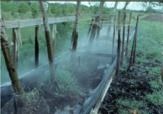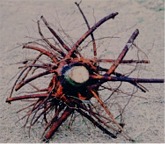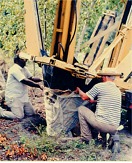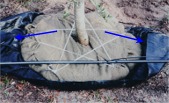Home > Nursery tree production > Root system > Field production > Research-base procedures
Research-based procedures
 Irrigation
and fertilization: Tree production practices in the field nursery impact transplantability. Some
tree species receiving drip irrigation at the base of the trunk for the duration
of the production cycle in the nursery often have a concentration of fine roots
in the root ball (Gilman et al,
1992; Ponder and Kenworthy, 1976). Drip and micro-spray irrigation appear
to provide a similar root response (Gilman
et al. 2002). Fine root growth on some species can also be stimulated close
to the trunk by making fertilizer applications only on soil that will become
the root ball, not outside the root ball (Beeson
and Gilman, 1995). Many nurseries fertilize trees in this manner.
Irrigation
and fertilization: Tree production practices in the field nursery impact transplantability. Some
tree species receiving drip irrigation at the base of the trunk for the duration
of the production cycle in the nursery often have a concentration of fine roots
in the root ball (Gilman et al,
1992; Ponder and Kenworthy, 1976). Drip and micro-spray irrigation appear
to provide a similar root response (Gilman
et al. 2002). Fine root growth on some species can also be stimulated close
to the trunk by making fertilizer applications only on soil that will become
the root ball, not outside the root ball (Beeson
and Gilman, 1995). Many nurseries fertilize trees in this manner.
On the other hand, one study showed that after trees received overhead irrigation and broadcast fertilization for two years in the nursery, concentrating the irrigation or fertilizer close to the trunk did not influence fine root growth (Beeson and Gilman, 1995). Apparently, to increase fine-roots near the trunk, irrigation and fertilizer application to the root ball area must begin soon after the tree is planted in the nursery field.
 Root
pruning: Circling roots and other root defects on liners should be cut and removed before planting into the field (See: cutting roots at planting). Some field nurseries routinely root prune tangent to the trunk certain species such
as oaks one or more times annually to help them survive the transplanting process.
Others prune only once several weeks to several months before harvesting (See: sample root pruning protocol). Some nurseries do not root prune
trees during production. Certain trees like holly, crapemyrtle, red maple and
others are not routinely root pruned because their root systems are dense and
fibrous. Root pruning during production can increase tree survival after digging,
but may have little or no impact on growth of surviving trees after transplanting
to the landscape (Gilman 1992; Gilman 2001).In warm climates,
without frequent irrigation after transplanting, trees pre-dug from a field
nursery or those root pruned repeatedly prior to digging them from the nursery
are less stressed after planting than freshly-dug trees. (Research in the cooler
climates is mostly lacking but conversations with some quality growers reveal
that many trees are not root pruned during production.) Trees that are root
pruned regularly during production may not need to be hardened-off (see below) for as long
as trees that are root pruned less rigorously prior to landscape planting.
Root
pruning: Circling roots and other root defects on liners should be cut and removed before planting into the field (See: cutting roots at planting). Some field nurseries routinely root prune tangent to the trunk certain species such
as oaks one or more times annually to help them survive the transplanting process.
Others prune only once several weeks to several months before harvesting (See: sample root pruning protocol). Some nurseries do not root prune
trees during production. Certain trees like holly, crapemyrtle, red maple and
others are not routinely root pruned because their root systems are dense and
fibrous. Root pruning during production can increase tree survival after digging,
but may have little or no impact on growth of surviving trees after transplanting
to the landscape (Gilman 1992; Gilman 2001).In warm climates,
without frequent irrigation after transplanting, trees pre-dug from a field
nursery or those root pruned repeatedly prior to digging them from the nursery
are less stressed after planting than freshly-dug trees. (Research in the cooler
climates is mostly lacking but conversations with some quality growers reveal
that many trees are not root pruned during production.) Trees that are root
pruned regularly during production may not need to be hardened-off (see below) for as long
as trees that are root pruned less rigorously prior to landscape planting.
On the other hand, if irrigation can be provided frequently (this is rare) until trees are established in the landscape, root pruning prior to transplanting has little impact on survival on trees with a trunk diameter less than 5 inches. Nurseries are usually best prepared to provide this intensive irrigation management required for freshly-dug trees. Freshly-dug trees usually cannot be irrigated properly in a landscape setting. Some deciduous trees in the cooler regions (hardiness zones 2 through 7) are not irrigated regularly after transplanting because they are dug and/or planted at the end of the dormant season. The cool weather and lack of foliage allows the tree to survive unless the region is experiencing drought. Arborists often root prune larger trees prior to moving them with the intention of improving transplant survival. Nursery operators usually like to harvest only root pruned trees in summer, although there are new techniques that could dramatically improve summer survival (Gilman et al. 2002).
 Burlap: Trees grown in the field and not harvested bare root are dug with a soil ball.
Burlap is secured around the root ball with nails, string or wire. Synthetic
burlap is occasionally used on root balls so the nursery operator can dig the
tree several months prior to planting it in the landscape. This pre-digging
helps the tree harden-off and survive
once transplanting into the landscape. However, synthetic burlap should be removed
at least from the upper portion of the root ball before backfilling. It is probably
best to remove all synthetic burlap. Although there are few published reports
of synthetic burlap preventing root regeneration or penetration into the backfill
soil, there are verbal accounts from landscapers and researchers of synthetic
burlap preventing root growth out of the root ball on certain species.
Burlap: Trees grown in the field and not harvested bare root are dug with a soil ball.
Burlap is secured around the root ball with nails, string or wire. Synthetic
burlap is occasionally used on root balls so the nursery operator can dig the
tree several months prior to planting it in the landscape. This pre-digging
helps the tree harden-off and survive
once transplanting into the landscape. However, synthetic burlap should be removed
at least from the upper portion of the root ball before backfilling. It is probably
best to remove all synthetic burlap. Although there are few published reports
of synthetic burlap preventing root regeneration or penetration into the backfill
soil, there are verbal accounts from landscapers and researchers of synthetic
burlap preventing root growth out of the root ball on certain species.
Recent
innovations: A recent innovation should eliminate the need for synthetic
burlap in a wire basket. It allows the tree to be held in the nursery for many
months after digging without producing large diameter roots out of the root
ball. Here is how the system works. Trees are dug and placed in natural burlap
then secured with wire or string to hold the root ball tight. The intact root
ball is lowered into a pre-dug hole in the nursery that is lined with a sleeve
made from black nursery ground cloth (see illustration at left).In several
weeks to a month or two depending on season of year and species, small regenerated
roots will grow partially through the fabric and hold it onto the outside of
the root ball.  This will allow the tree to be held in the nursery for many months
and then lifted without loosing soil from the ball. The natural burlap may have
decomposed but the sleeve on the outside of the ball will be intact and will
hold the soil in the root ball. Of course the synthetic sleeve on the outside
of the ball must be stripped away from the rootball and removed at the planting
site.
This will allow the tree to be held in the nursery for many months
and then lifted without loosing soil from the ball. The natural burlap may have
decomposed but the sleeve on the outside of the ball will be intact and will
hold the soil in the root ball. Of course the synthetic sleeve on the outside
of the ball must be stripped away from the rootball and removed at the planting
site.
Hardening-off trees: Field-grown trees dug several weeks or months prior to shipping to the landscape site are said to be "hardened off". Freshly dug trees are not "hardened off" and are very susceptible to death if not watered appropriately (Gilman 2001). During the "hardening off" period, roots begin to grow within the root ball, and the tree may drop some leaves. There may be other physiological adjustments made by the tree that are not now well understood. Roots often grow through the burlap wrapped around the root ball of a hardened off tree. Some nurseries provide overhead irrigation to the foliage during the hardening off period, especially with summer digging. Purchasing freshly dug trees in the southern US that are not hardened-off is not recommended unless you have assurances that they were regularly root pruned during production.

